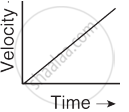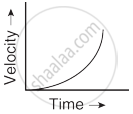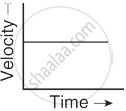Advertisements
Advertisements
Question
Match the Following.
| Sr. No. | List I | List II | |
| 1. | Motion of a body covering equal distances in equal interval of time | A. |  |
| 2. | Motion with non uniform acceleration | B. |  |
| 3. | Constant retardation | C. |  |
| 4. | Uniform acceleration | D. |  |
Solution
| Sr. No. | List I | List II | |
| 1. | Motion of a body covering equal distances in equal interval of time | D. |  |
| 2. | Motion with non uniform acceleration | C. |  |
| 3. | Constant retardation | A. |  |
| 4. | Uniform acceleration | B. |  |
APPEARS IN
RELATED QUESTIONS
Give two examples of bodies having non-uniform motion.
Fill in the blank:
36 km h-1 = ______
An object has moved through a distance. Can it have zero displacement? If yes, support your answer with an example.
The area under a speed-time graph represents a physical quantity which has the unit of :
A motorcycle is being driven at a speed of 20 m/s when brakes are applied to bring it to rest in five seconds. The deceleration produced in this case will be :
How does the earth revolve?
Motion is of ______ types.
Paheli moves on a straight road from point A to point C. She takes 20 minutes to cover a certain distance AB and 30 minutes to cover the rest of distance BC. She then turns back and takes 30 minutes to cover the distance CB and 20 minutes to cover the rest of the distance to her starting point. She makes 5 rounds on the road the same way. Paheli concludes that her motion is
A body repeating its motion after a certain interval of time is in ______ motion.
Time is a vector quantity.
